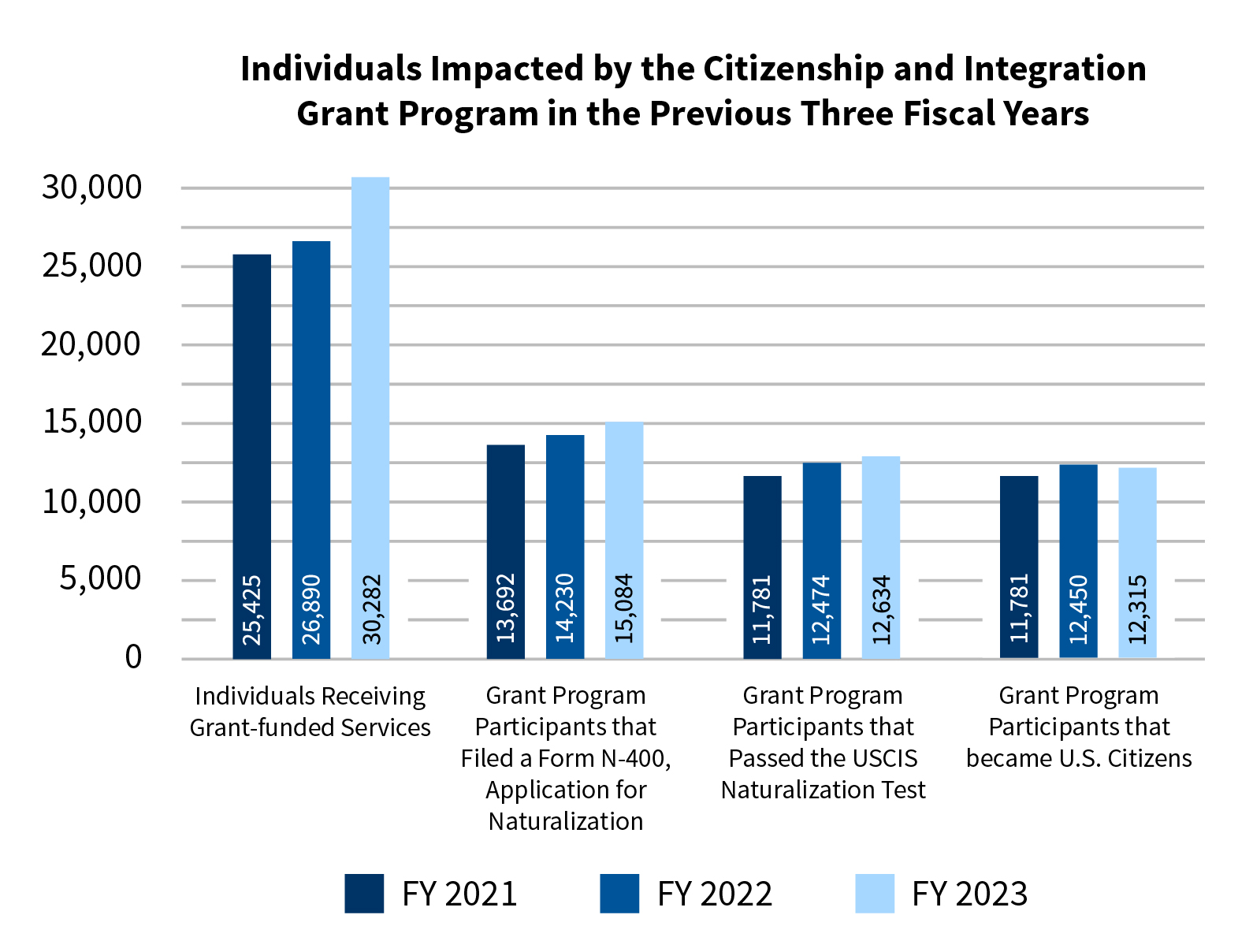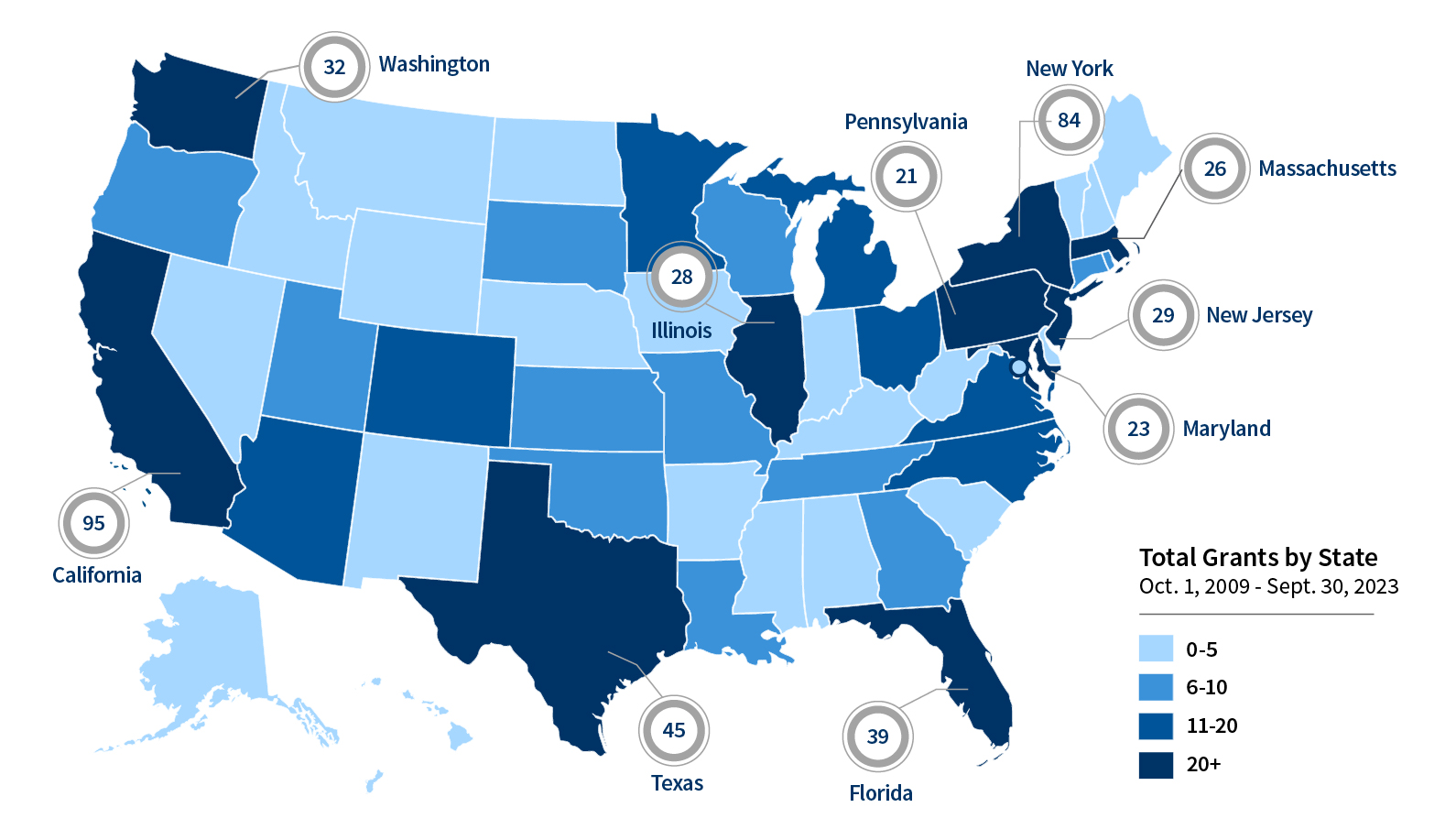Grant Program Impact

USCIS Citizenship and Assimilation Grant Program (CIGP) Overview
While many immigrants wish to become U.S. citizens, real and perceived barriers to naturalization often prevent individuals from pursuing naturalization. Each year, approximately 10 percent of those eligible to naturalize do so, and this trend has persisted for decades. As a result, there are currently 9 million lawful permanent residents (LPRs) (PDF) eligible to apply for citizenship in the United States.
The USCIS CIGP provides support to community-based, non-profit organizations and educational institutions actively working to remove barriers to naturalization. The goal of the CIGP is to expand the availability of high-quality citizenship preparation services for LPRs across the nation and to provide opportunities for immigrants to gain the knowledge and skills necessary to assimilate into the fabric of American society. USCIS grant recipients provide English language and civics instruction, legal assistance with naturalization applications, and create community space for immigrant assimilation. Recipients of the CIGP have included various types of organizations such as community and faith-based groups, public libraries, and adult education and literacy organizations.
Since it began in 2009, the CIGP has awarded more than $155 million through 644 competitive grants to immigrant-serving organizations in 41 states and the District of Columbia. Now in its 16th year, the program has helped more than 350,000 LPRs prepare for citizenship.
The below table highlights the specific impact of the grant program in the past three fiscal years.


USCIS publishes an annual Citizenship and Integration Grant Program Fact Sheet, which provides additional information on the characteristics and outcomes for grant program participants. Please note that Fact Sheets are published well after the end of each performance period, to capture accurate outcomes for all program participants and allow adequate processing times for participants that have submitted a Form N-400, Application for Naturalization. Below this accordion is a list of all currently available Fact Sheets:
USCIS maintains a comprehensive list of all organizations that have received a CIGP award or subaward. Navigate to the below links to learn more about the type of grants offered, which organizations received grants, and the amounts awarded to each organization within each fiscal year.
| FY | Amount(in Millions) | Number of Organizations Served | Performance Period Start | Performance Period End |
|---|---|---|---|---|
| 2009 | $1.2 | 13 | October 1, 2009 | September 30, 2010 |
| 2010 | $8.1 | 78 | October 1, 2010 | September 30, 2012 |
| 2011 | $9 | 42 | October 1, 2011 | September 30, 2013 |
| 2012 | $5 | 31 | October 1, 2012 | September 30, 2014 |
| 2013 | $9.9 | 40 | October 1, 2013 | September 30, 2015 |
| 2014 | $10 | 40 | October 1, 2014 | September 30, 2016 |
| 2015 | $10 | 40 | October 1, 2015 | September 30, 2017 |
| 2016 | $10 | 46 | October 1, 2016 | September 30, 2018 |
| 2017 | $10 | 45 | October 1, 2017 | September 30, 2019 |
| 2018 | $10 | 40 | October 1, 2018 | September 30, 2020 |
| 2019 | $10 | 41 | October 1, 2019 | September 30, 2021 |
| 2020 | $10 | 39 | October 1, 2020 | September 30, 2022 |
| 2021 | $10 | 40 | October 1, 2021 | September 30, 2023 |
| 2022 | $20 | 66 | October 1, 2022 | September 30, 2024 |
| 2023 | $22 | 65 | October 1, 2023 | September 30, 2025 |
Over the past 16 years, USCIS has offered a variety of funding opportunities, each with different program requirements and objectives. The section below provides an overview of the types of grants USCIS has provided in the past three fiscal years, information about the objectives of each funding opportunity, and how USCIS has measured performance. Under all CIGP awards, grant recipients report on all performance metrics quarterly throughout the duration of the period of performance.
Citizenship Instruction and Naturalization Application Services Grants (CINAS)

USCIS measures CINAS grant recipient performance through the following metrics:
- Number of newly enrolled (non-duplicated) LPRs to enroll in citizenship instruction classes;
- Percentage of enrolled students who post-test using a nationally normed standardized test;
- Percentage of post-tested students demonstrating measurable educational gains (as measured by one percentage point between pre and post-test);
- Number of LPRs for whom the organization will provide naturalization eligibility screenings for Form N-400;
- Number of LPRs for whom the organization will prepare and file Form N-400 and Form G-28.
Community and Regional Integration Network Grants (CARING)

The CARING funding opportunity supports organizations providing extended civic integration services to specific, vulnerable immigrant populations, such as refugees and asylees. Like the CINAS grant, CARING grant recipients provide citizenship classes and naturalization application services. However, unlike the CINAS grant, CARING program participants may qualify for services with a lower level of English language skills, in recognition of the fact that many refugees and asylees have not had access to the same educational opportunities as other aliens due to their experiences being displaced. Additionally, grant organizations develop individualized integration plans for each immigrant that participates in the program. USCIS measures CARING grant recipient performance through the following metrics:
- Number of integration plans developed;
- Number of newly enrolled (non- duplicated) immigrants to enroll in citizenship instruction classes;
- Percentage of enrolled students who post-test;
- Percentage of post-tested students demonstrating measurable educational gains;
- Number of immigrants for whom the organization will provide naturalization eligibility screenings;
- Number of immigrants for whom the organization will prepare and file Form N-400 and Form G-28.
Regional Hub Grants

In FY 2022, USCIS awarded three Regional Hub grants of up to $1 million each. USCIS offered this grant again in FY 2023 but did not award any Regional Hub grants that year. The primary awardee also is responsible for serving as a hub for communication and information sharing on citizenship preparation within the broader community. USCIS measures Regional Hub grant recipient performance through the following metrics:
- Number of regular stakeholder engagements held by primary applicant;
- Number of individuals who attend each stakeholder engagement;
- Number of newly enrolled (non- duplicated) immigrants in citizenship instruction classes (total and per sub-applicant);
- Percentage of enrolled students who post-test using nationally normed standardized tests of English language proficiency (total and per sub-applicant);
- Percentage of post-tested students demonstrating measurable educational gains (total and per sub-applicant);
- Number of immigrants for whom each sub-applicant provides naturalization eligibility screenings;
- Number of immigrants for whom each sub-applicant prepares and files Forms N-400 and G- 28.
Innovations in Citizenship Preparation Grants

This funding opportunity announcement was designed to support and amplify innovative approaches to preparing immigrants for naturalization and encouraging the civic, linguistic, economic, and cultural integration of immigrants into their communities. While USCIS’ other funding opportunities support specific citizenship preparation services, the Innovations program invests in initiatives that develop, test, and share creative solutions for overcoming barriers to naturalization and expanding access to citizenship education and preparation services. Through this funding opportunity, organizations develop, test, and share creative solutions for overcoming traditional barriers to naturalization. When USCIS first offered Innovations grants in FY 2022, the grant was called Innovations in Citizenship Education and awardees were asked to select two of more performance metrics from the following list:
- Number of students that enroll in a citizenship education class as a result of the innovation;
- Percentage of students that demonstrate measurable learning gains as a result of the proposed innovation;
- Number of students or participants that file Form N-400, Application for Naturalization, as a result of the proposed innovation;
- Number of new community partnerships created, as evidenced by a Memorandum of Understanding, to support the citizenship preparation and/or integration of immigrants in the community;
- Number of “hard to reach” immigrants engaged through targeted citizenship outreach campaign;
- Number of immigrants who are trained on (or use) a new citizenship education tool.
In FY 2023, USCIS renamed to grant Innovations in Citizenship Preparation, updated the program design to reflect lessons learned during the first year, and began measuring performance through the following metrics:
- Did the recipient submit a revised project plan no later than December 30, 2023? (yes/no)
- Did the recipient complete the development of their innovation to the specifications of their proposal and project plan no later than December 30, 2024? (yes/no)
- Did the recipient test and refine their innovation as needed, and then share publicly in accordance with their project plan? (yes/no)
